Aleksey Shpilevsky started his coaching career relatively young when he was forced to retire from professional football due to a severe back injury. At just 21 years old, the Belarusian started his youth managerial career in Germany with fifth-tier side Sonnenhof Großaspach. He then quickly moved higher up the ranks, with coaching stops in the youth ranks of both Vfb Stuttgart and five years at RB Leipzig.
His first big managerial job came at Kazakh side Kairat, where he managed the first team for three seasons, winning one Kazakhstan Premier League title during his time in charge. After a brief spell in Germany, he came to Cyprus, where he is currently doing rather well at Aris Limassol. After being appointed near the end of the 2021/22 season, his first entire season in charge, 2022/23, he managed to win the league and cup double with the Cypriot side, Aris Limassol’s first league title in the club’s history. He has also guided them into the UEFA Europa League this season, where they have recorded a historic win against Scottish powerhouse Rangers.
So far, early into this season, Aris are once again challenging for the title in Cyprus, with the club sitting in 3rd place, three points back of league leaders APOEL Nicosia. This tactical analysis will take a more in-depth look at the tactics of the 35-year-old manager, with this being an analysis of how his Aris Limassol side look to play in different phases of play and how Shpilevsky has adapted his coaching education into the professional ranks with the Cypriot side.
Attacking phase
Considering that Aleksey Shpilevsky came through the youth coaching ranks at RB Leipzig, it is quite easy to imagine how he may look for his Aris Limassol side to play in the attacking phase. Under Shpilevsky, Aris have become a very possession-oriented football team, with the club averaging 55.4% possession in matches thus far. Before he was appointed near the end of the 2021/22 season, Aris’s possession numbers were well lower; in fact, they were just over 46% average possession throughout that season.
Regarding ball progression, Aris are a side that look to build out from the back with their goalkeeper, though playing long is not something that Shpilevsky shies away from. Aris’s 527 long passes rank third highest in the Cypriot First Division this season, showing this tendency. However, this is still not route one for them, with a passing rate of 13 this season, offering a more possession-based style. Let’s look at some chance creation numbers for Aris Limassol this season to see how they look to create the majority of their goalscoring chances.
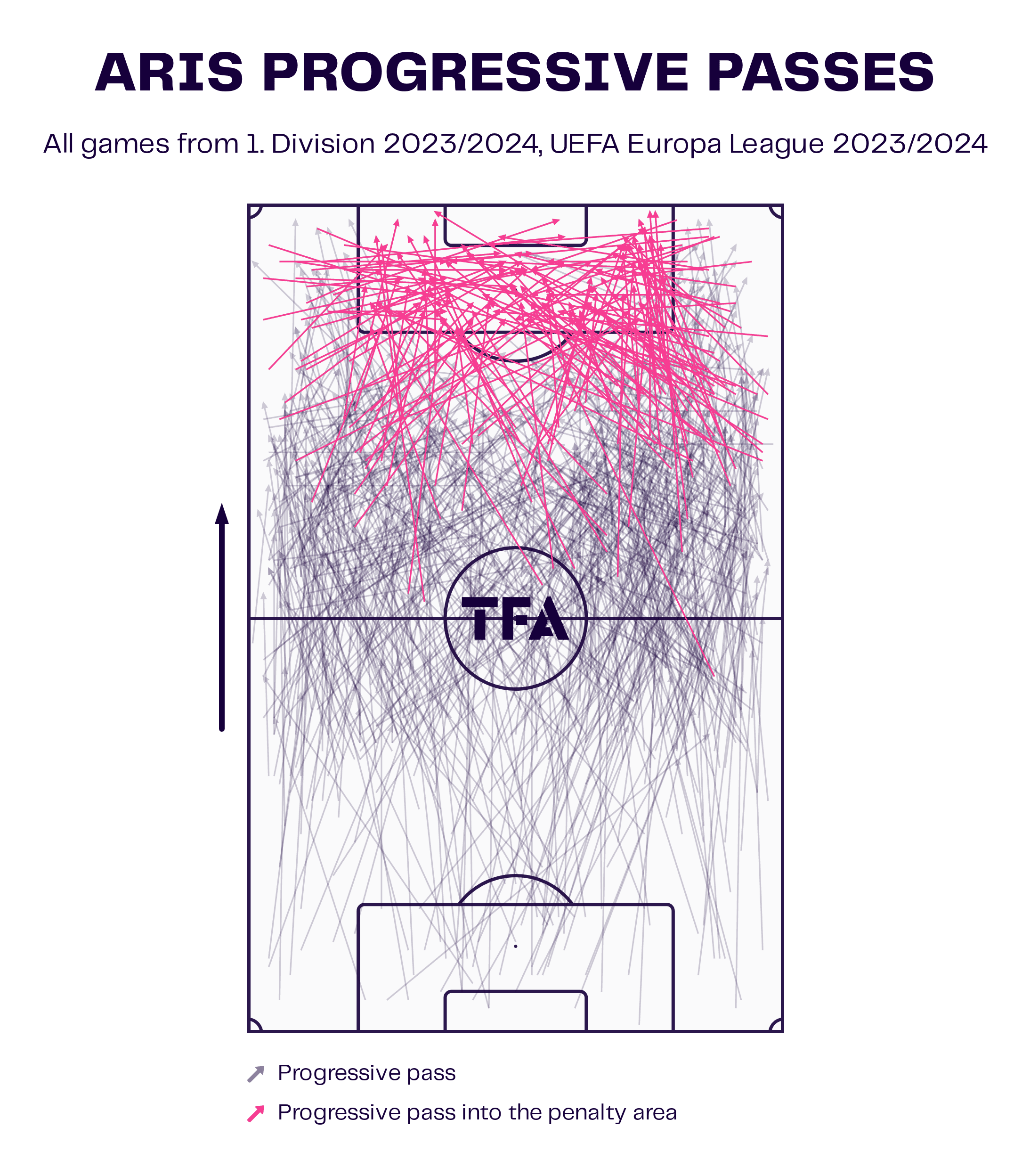
Regarding ball progression and chance creation for Aris Limassol, the data viz graphic above shows the progressive passes of the Cypriot club this season in both the Cypriot First Division and the Europa League. We can see that the majority of progressive passes into the penalty area for Aris have come from the wide areas, with Shpilevsky looking to rely on his wide players to send crosses into the box to create goalscoring chances. Aris’s 204 crosses this season rank third-highest in Cyprus, highlighting even more how Aris aim to utilise the entire pitch width during attacking phases of play. Looking at different passing statistics in general shows how frequently Aris look to progress the ball into the opponent’s final third and their prioritisation on verticality, with Aris also ranking top of the Cypriot First Division in through passes (103), passes to the final third (698), and progressive passes (887).
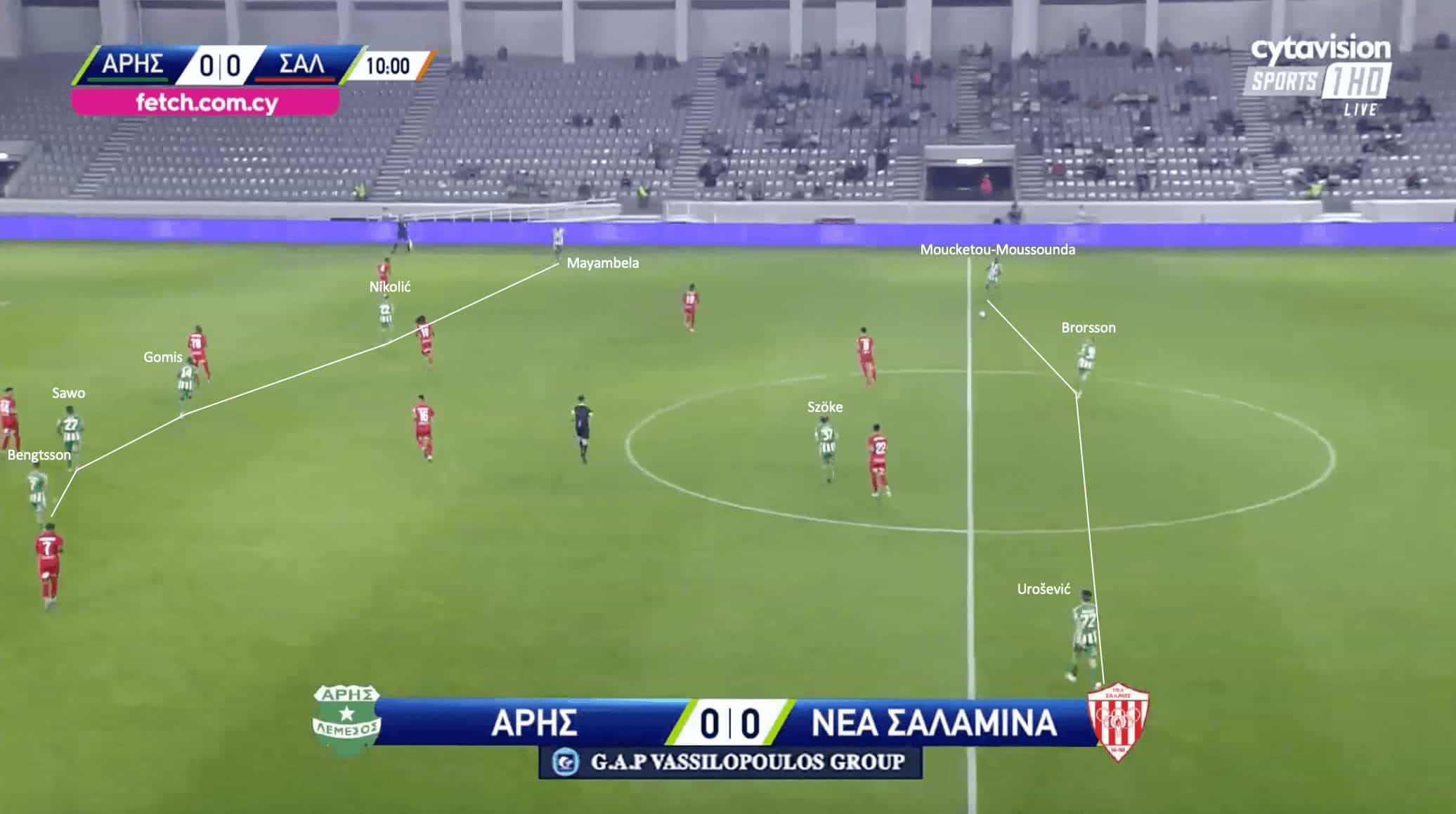
Regarding formational shapes for Aris, Aleksey Shpilevsky tends to alternate at times, with his starting formation not staying the same as the match progresses or even from match to match. During the course of this season, Shpilevsky has tended to start matches in some version of a back four, usually either a flat 4-4-2 or a 4-2-3-1. However, as the image above highlights, Aris have tended to attack in more of a back three shape.
In this phase of play from a recent league match against Nea Salamis, the current Cypriot champions are in possession and building from the back. As we can see from the image, the attacking shape has turned into a 3-1-6, with the left-sided full-back, Cajú, holding the width out of the picture on the near touchline. Aris have tended to build in this shape throughout this season, with Shpilevsky’s side looking to stretch opposition defences and look to pin opposition backlines deep, with attackers looking to make runs off the forward line and into the midfield to receive the ball in pockets of space in advanced positions. This is where the emphasis on verticality comes into Aleksey Shpilevsky’s style of play and where his tactics come full circle with his Red Bull coaching education.
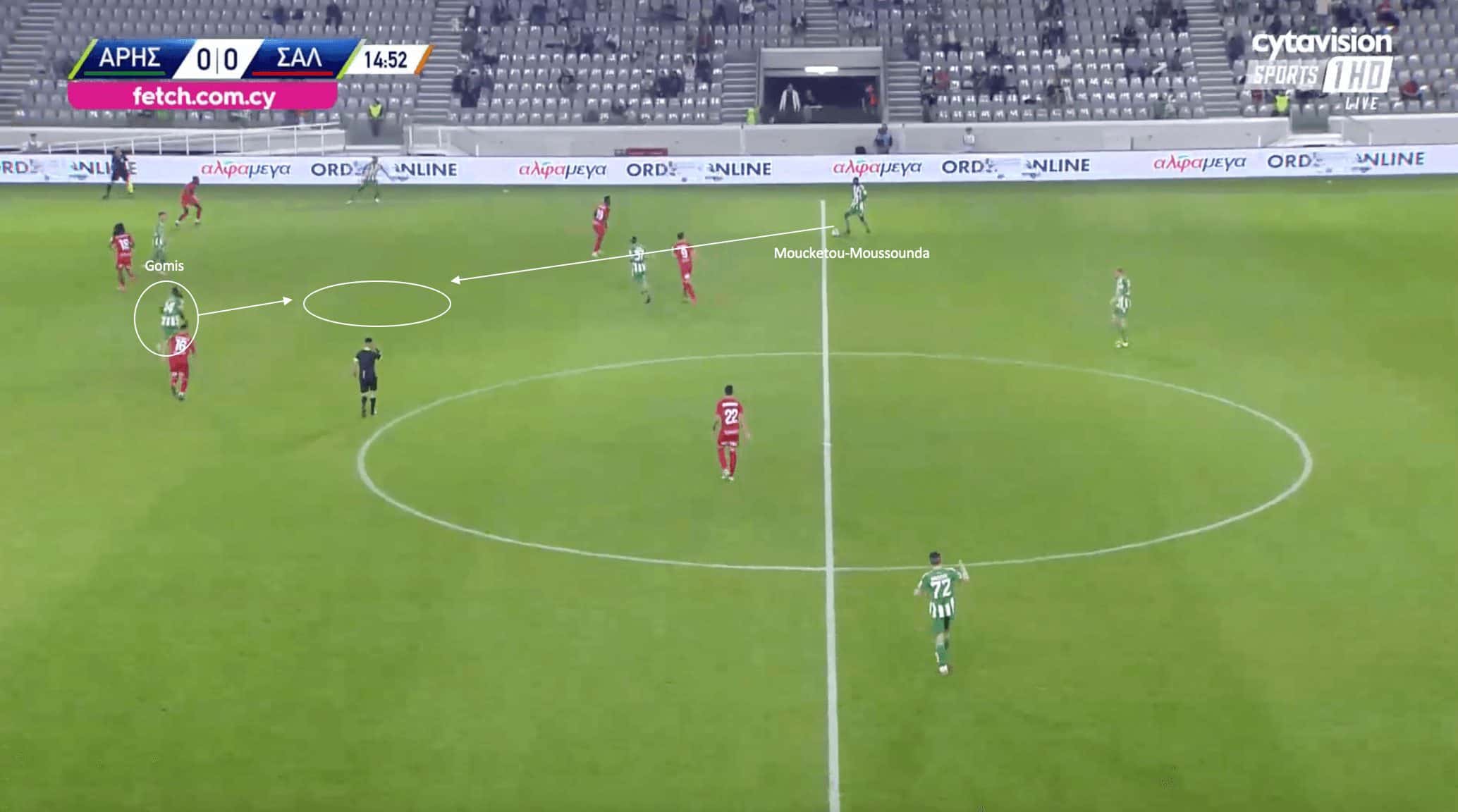
The image above shows a better look at Shpilevsky’s emphasis on verticality and why Aris look to pin opposition backlines deep with either five or six in the front line. In this attacking phase against Nea Salamis, the ball is in possession of the right-back, who has transitioned into a right-sided centre-half, Alex Moucketou-Moussanda. Notice the gap between the opposition lines due to the positioning of the furthest advanced Aris players.
This positioning and attacking formational shape is able to open up large pockets of space for Aris to look and exploit, allowing them to quickly progress the ball into the attacking third with quick and incisive passing moves. Here, Cameroonian forward Yannick Gomis drops into the pocket of space, allowing him to receive the pass from the Gabon defender with some time and space. Though the midfielder can engage the forward, Gomis can spin away and drive towards the pinned backs, with the Aris attackers able to create a goalscoring chance.
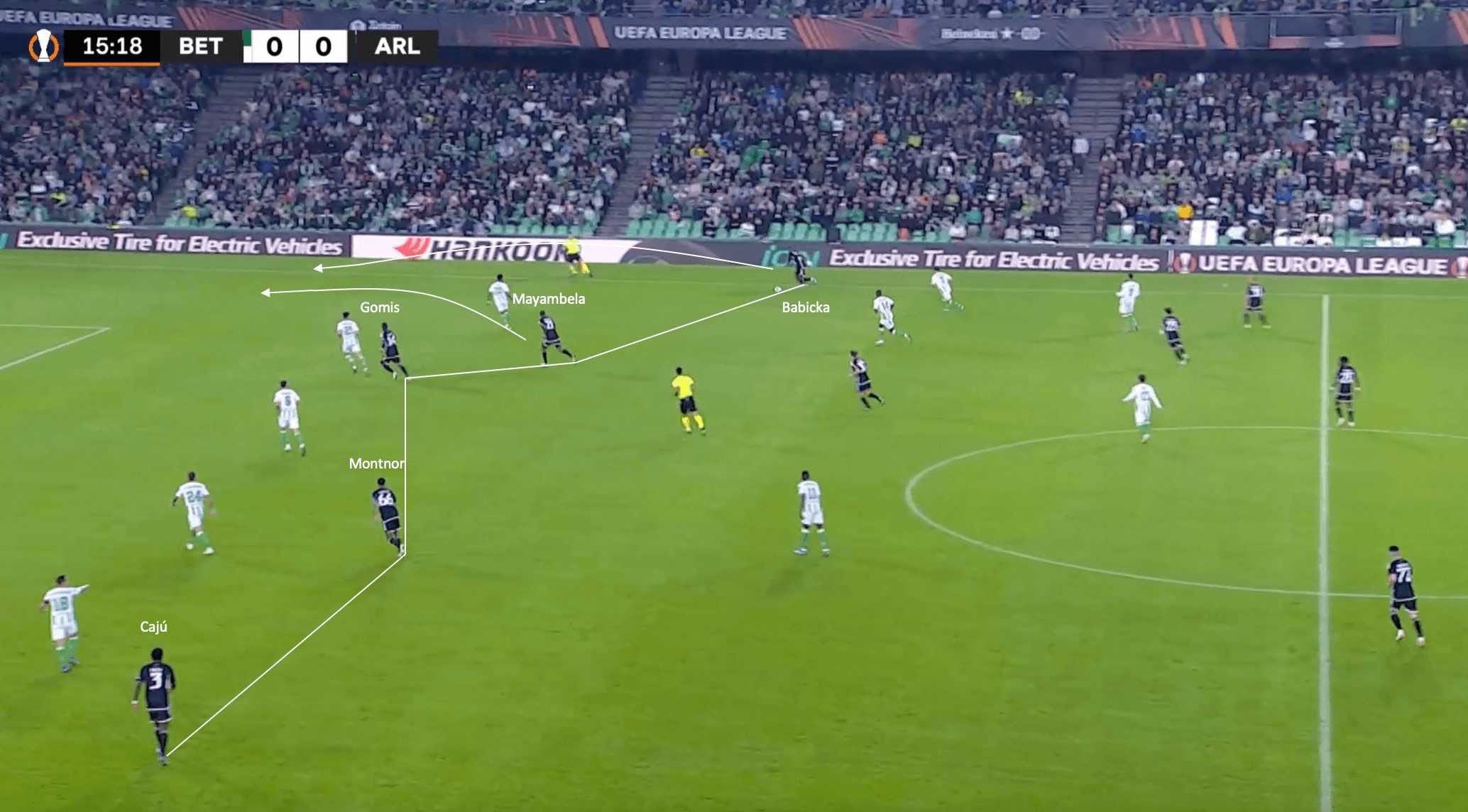
The figure above from Aris’s recent Europa League match against Spanish side Real Betis shows another excellent example of what Aleksey Shpilevksy has been able to implement on the attacking side of things during his time in Cyprus. The ball is currently in possession of Gabon international forward Shavy Babicka, with the 23-year-old forward in possession on the far touchline. As similar to the previous examples, Aris are pushing numbers forward onto the backline, with the attacking shape looking like a 3-2-5.
This forces the Real Betis defence to get pinned back, with a sizable gap opening between the defensive and midfield lines of the La Liga side. This is where the principle of verticality comes into effect for Shpilevsky’s side. Instead of playing a square pass into the midfield and running into the pocket, Babicka looks to play behind the Real Betis backline. With the full-back occupied by focusing on the Gabonese forward, the left-sided central defender is stuck in a 2v1 against Gomis and Mihlali Mayambela. As a result, Mayambela can sneak between the full-back and centre-back, with Babicak playing a perfectly weighted ball into his path, with this attacking move leading to an Aris corner kick.
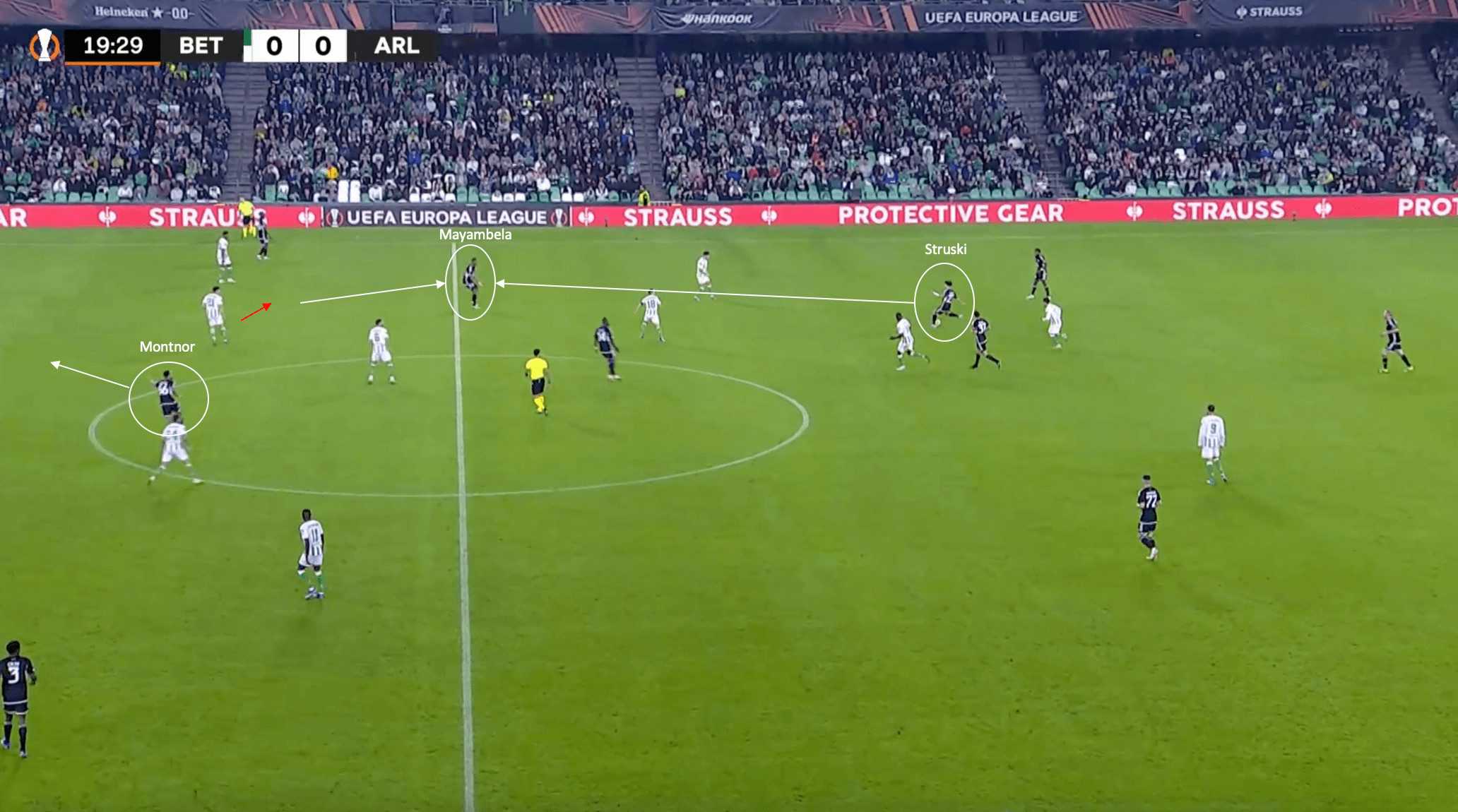
Another slick and incisive attacking move from Aris is shown in the figure above, resulting in a goal that was ruled out for offside. In this Aris attacking phase of play, the Cypriot side are operating in a 3-2-5 shape, with the Real Betis backline pinned deep and gaps being formed between the Real Betis lines. The ball is in possession of Polish midfielder Karol Struski, with the 22-year-old able to play the ball vertically to Mayambela. The South African attacker drops off of the backline and into the pocket of space that opens up in the midfield, with the Real Betis central defender keeping an eye on him and not noticing the movement on his back by Dutch attacker Jaden Montnor.
As a result, Mayambela is able to gain possession before turning and playing a pass behind the Real Betis defence and into the path of the Dutch forward. Montnor scores, but the goal is ruled out for offside. However, this again shows the type of attacking style Aleksey Shpilevsky has implemented at Aris, which looks to utilise verticality and off-the-ball movement along with quick and incisive passing.
As this section has illustrated, Aleksey Shpilevsky has been able to implement some Red Bull-themed attacking tactics into his Aris Limassol side. This use of verticality and quick and intelligent ball progression has allowed the Cypriot club to become one of the most entertaining sides in the division and a fun side to watch when they are in possession of the football.
Defensive phase & pressing ability
When analysing Aris Limassol from a defensive perspective, Aleksey Shpilevsky’s side are one of the more physical sides in the Cypriot First Division. In fact, Aris’s challenge intensity of 6.6 is the second highest in Cyprus, with only Anorthosis possessing a higher challenge intensity. This metric looks at duels, tackles and interceptions per minute of opposition possession, highlighting the physicality this Aris side display.
Their 12 goals conceded this season is one of the lower totals in the Cypriot First Division this season, though league leaders APOEL have only conceded six this season thus far. Regarding shots against, Aris’s 113 shots against is level with league leaders APOEL and very close to the lowest total in the division.
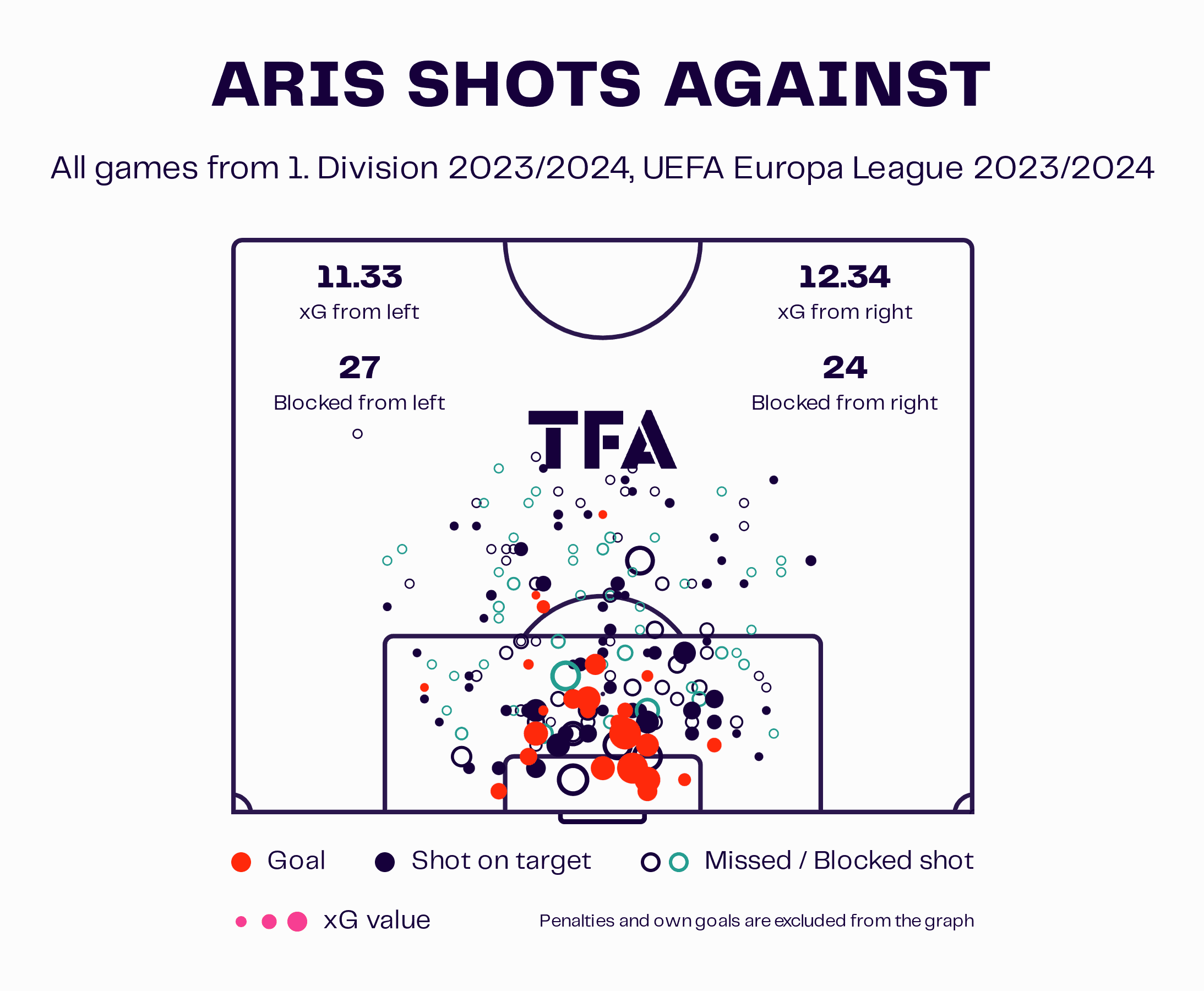
The data viz graphic above shows Aris Limassol’s shots against this season in both the Europa League and Cypriot First Division, giving a good picture of why they possess one of the best defensive records this season. As we can see from the graphic, many opponent shots against Aris have come from well outside of the penalty area, with most of them being blocked by Aris defenders or shot off target.
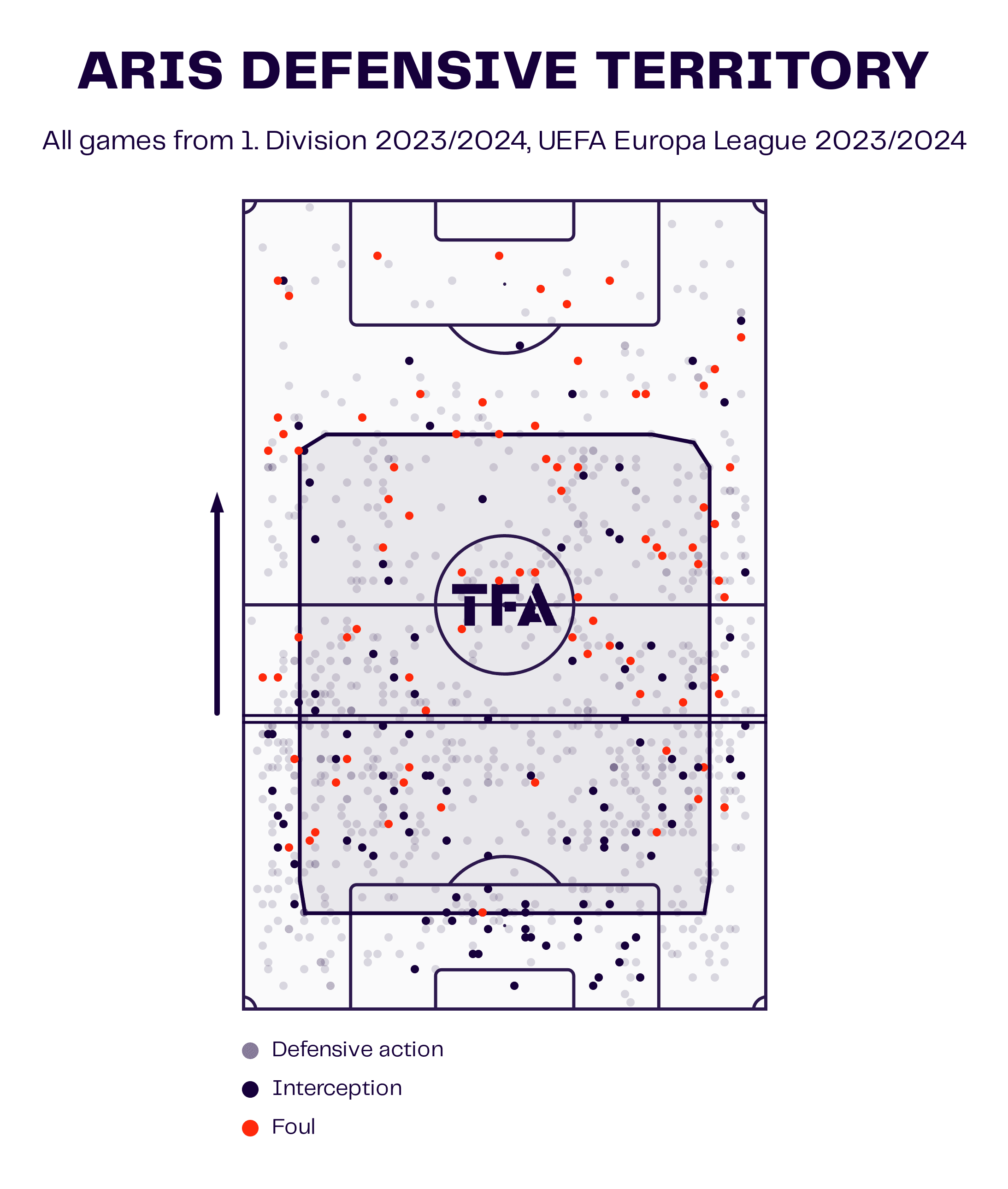
The Cypriot side also rank in the top five in Cyprus in defensive duels, aerial duels, and interceptions, showing their physicality and willingness to go into tackles to prevent opposition sides from getting shots on target. This data viz graphic shows all the defensive actions of Aris, as well as the average height of their defensive line and average area of engagement. Shpilevsky likes to play a high defensive line with Aris, another relatively common principle in the Red Bull sides. This can occasionally leave them exposed defensively, which is one reason they have conceded the joint most goals in the top six of the division.
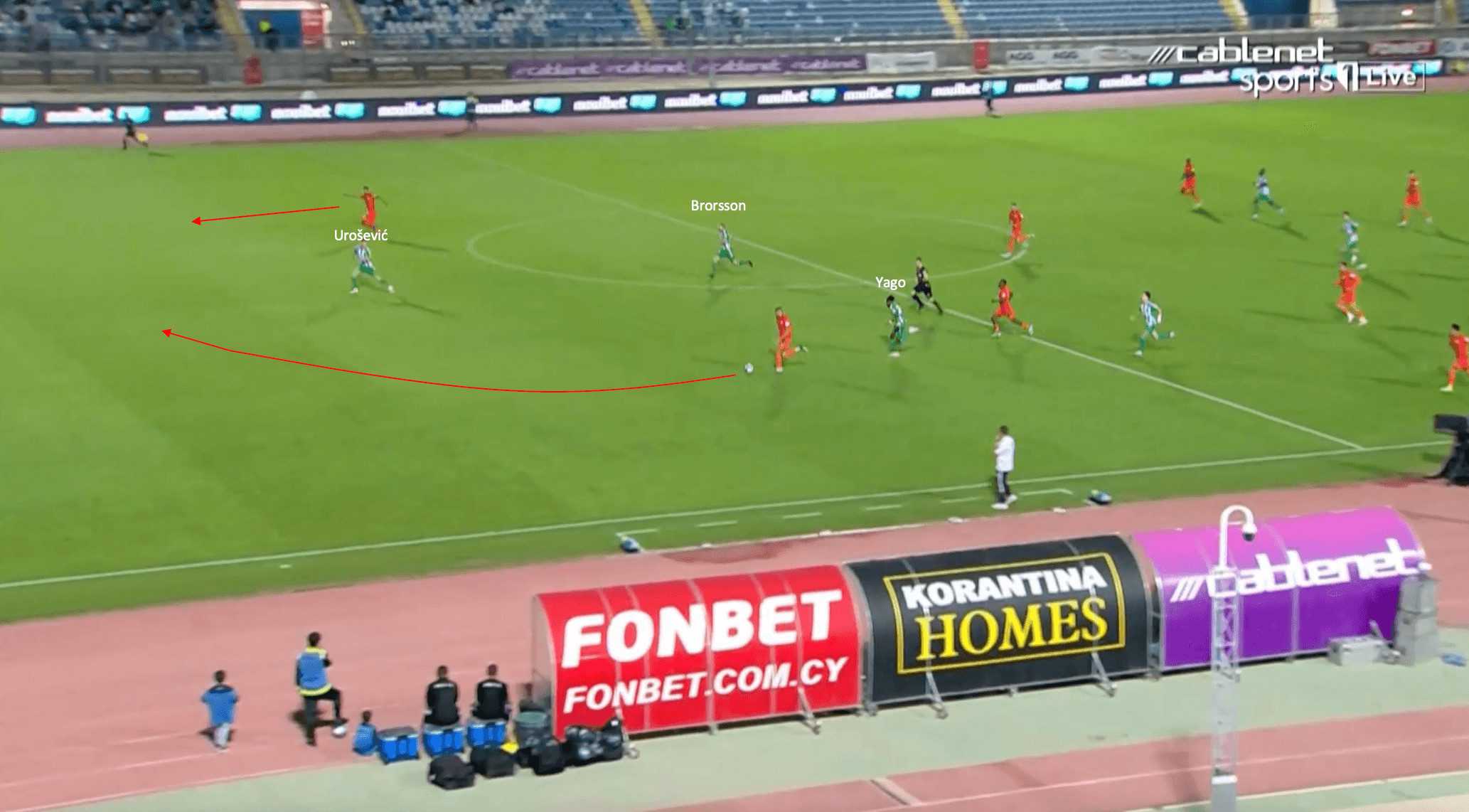
This figure above shows the problem that sometimes arises for Aris due to their tendency to play such a high defensive line. In this phase of play above from their most recent league match against Karmiotissa, we can see how stretched and high the Aris backline is, especially with the amount of numbers Shpilevsky looks to commit to the attacking phase. Though this does not lead to a goal for the opposition, it shows a situation that Aris find themselves in on occasion. However, using a high line is okay, with most dominant, possession-oriented sides looking to use a high line to keep opposition sides pinned in when they are looking to attack.
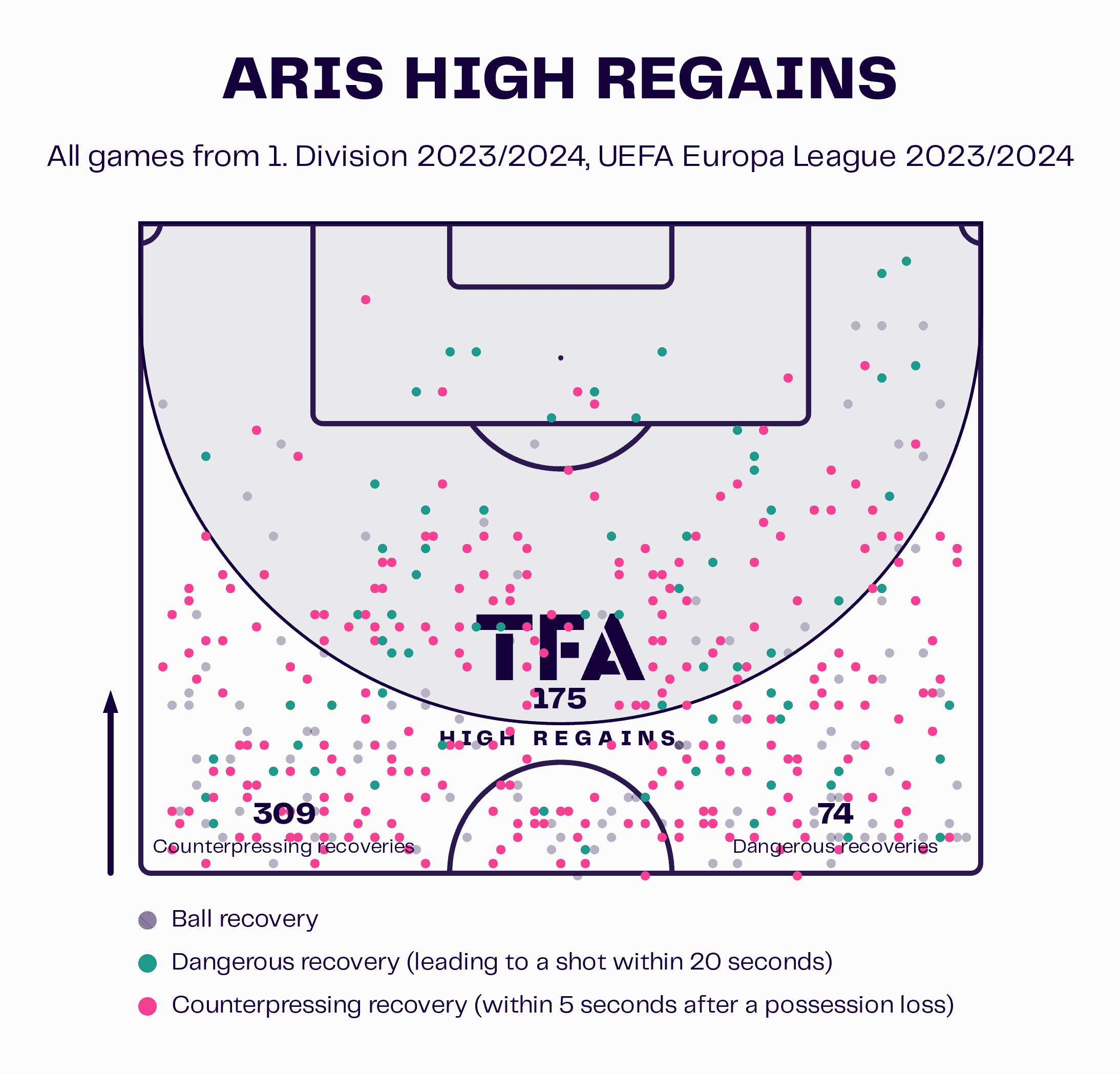
Another defensive principle that Aleksey Shpilevsky has implemented during his time with Aris is a relatively aggressive pressing philosophy. As the graphic above shows, Aris are one of the best pressing sides in Cyprus, with their 7.69 PPDA, the fourth-highest in the league. Shpilevsky’s pressing philosophy is not one that involves consistent pressure on the player in possession but a more strategic style that looks to lock the opposition to one side before committing numbers towards the ball to win possession.
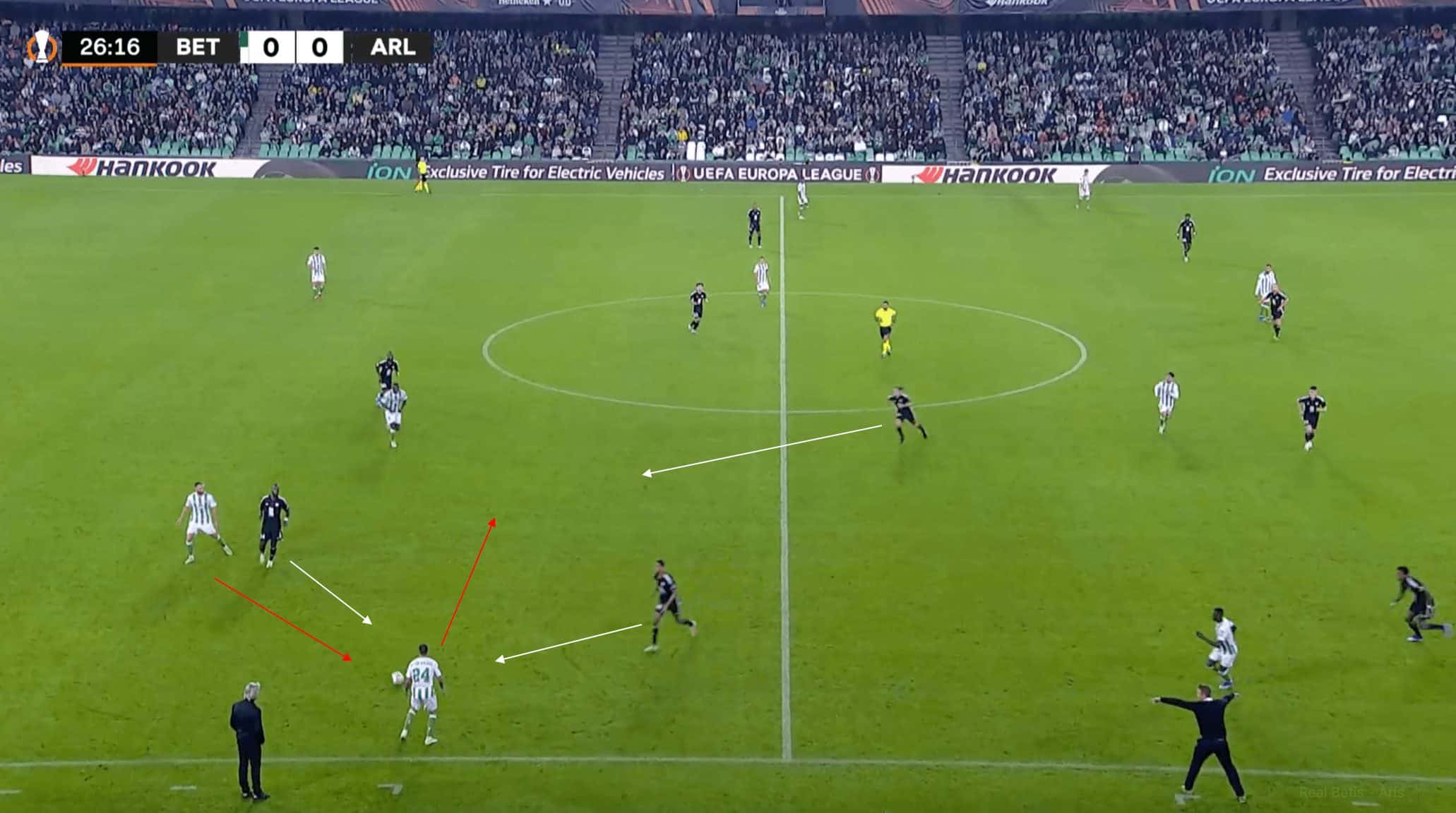
This style of pressing by Aris is shown in this figure above from their Europa League match against Real Betis. When the Betis centre-back is in possession, the two forwards from Aris look to shift the ball to one side, forcing the defender to play towards the near touchline. As the ball is played to the full-back, the Aris press is activated, with the striker and wide midfielder looking to put immediate pressure on the full-back. At the same time, the central midfielder notices the pocket of space and drives into it, with the locking of play forcing the full-back to play this predictable pass. As a result of the midfielder’s movement, the Betis player is forced to play the ball long first time, with the Aris goalkeeper able to claim and the Cypriot side able to reset.
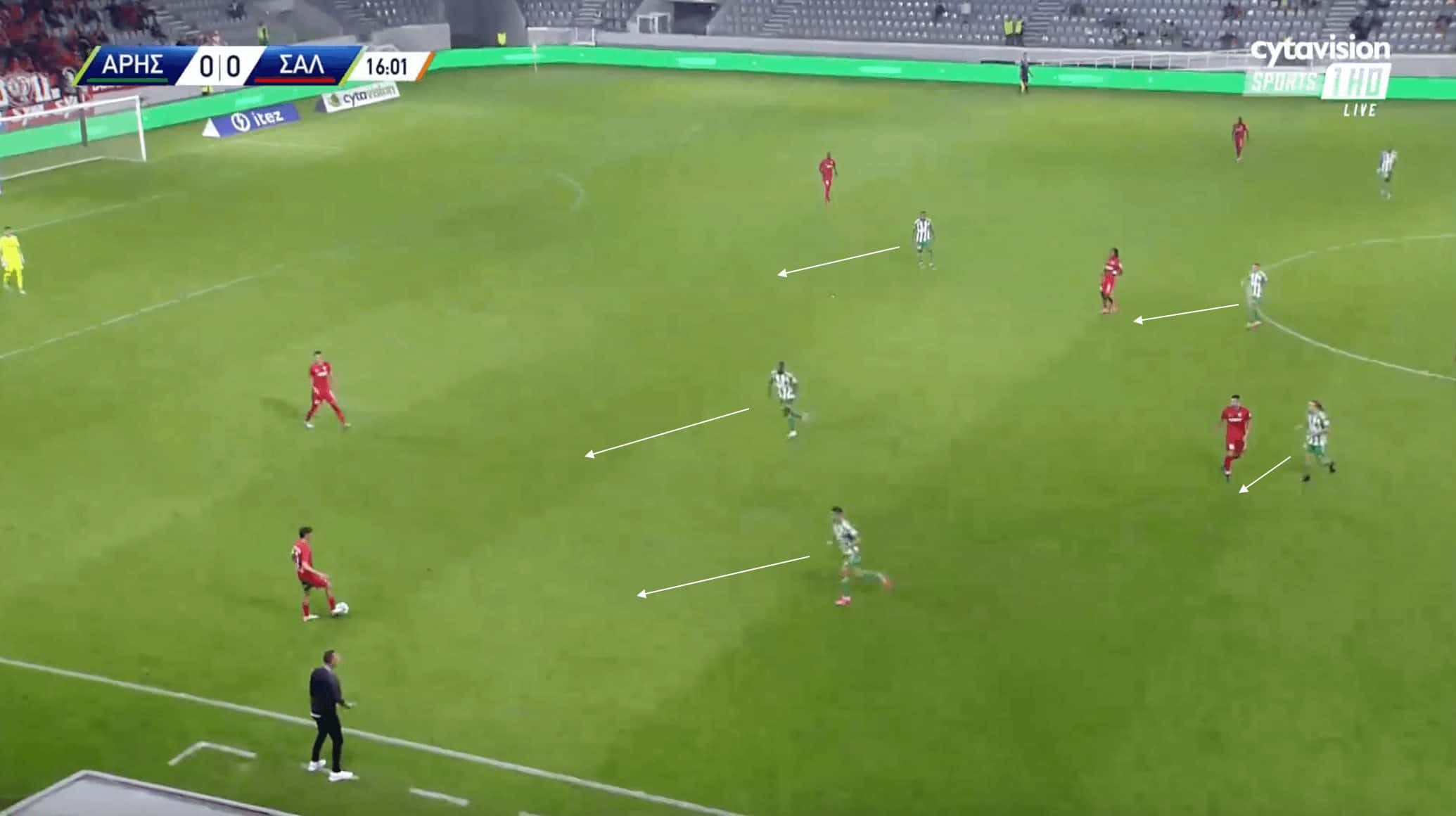
This final example again shows the Belarusian coaches’ philosophy of locking the ball to one side in a more organised press rather than being super aggressive and man-to-man pressing or just chasing the ball. In this pressing phase against Nea Salamis, the opposition side are building out from the back, with the ball being played to the full-back. As the ball is played, the Aris defensive shape looks to shift to this side and attempt to lock the ball, looking to force either a turnover or a ball played long.
In this example, the angle to switch it is still available, and Nea Salamis are able to do that. However, Aris then looked to press aggressively as the ball was played very heavily to the goalkeeper. This forces the keeper to clear the ball long, with Aris able to win the aerial duel and retain possession. As this section has illustrated, from a pressing perspective, Aris are a little more cautious when putting too much pressure on the opposition defenders in possession, instead looking to lock the ball to one side before engaging. From a defensive perspective, Shpilevsky’s use of a high defensive line has been prone to occasionally conceding goals. Still, their aggressive defensive nature in the attacking third helps to minimise this risk.
Who has Shpilevsky been able to make a key player for Aris?
This final section will look at some players who have become vital contributors for Aris this season under Aleksey Shpilevsky. With last season being the Belarusian coach’s first full season in charge and leading the Cypriot side to a league and cup double, there was definitely pressure on the 35-year-old coach to continue developing the squad and winning more silverware, especially with the added addition of Europa League football this season.
The first player to look at is 31-year-old Senegalese striker Yannick Gomis. With 10 goals in all competitions already this season, he has already surpassed his total of nine goals in all competitions from last season for Aris. Shpilevsky has turned the forward into a more potent goalscorer, as evidenced by the goalscoring stats in the early days of this season.
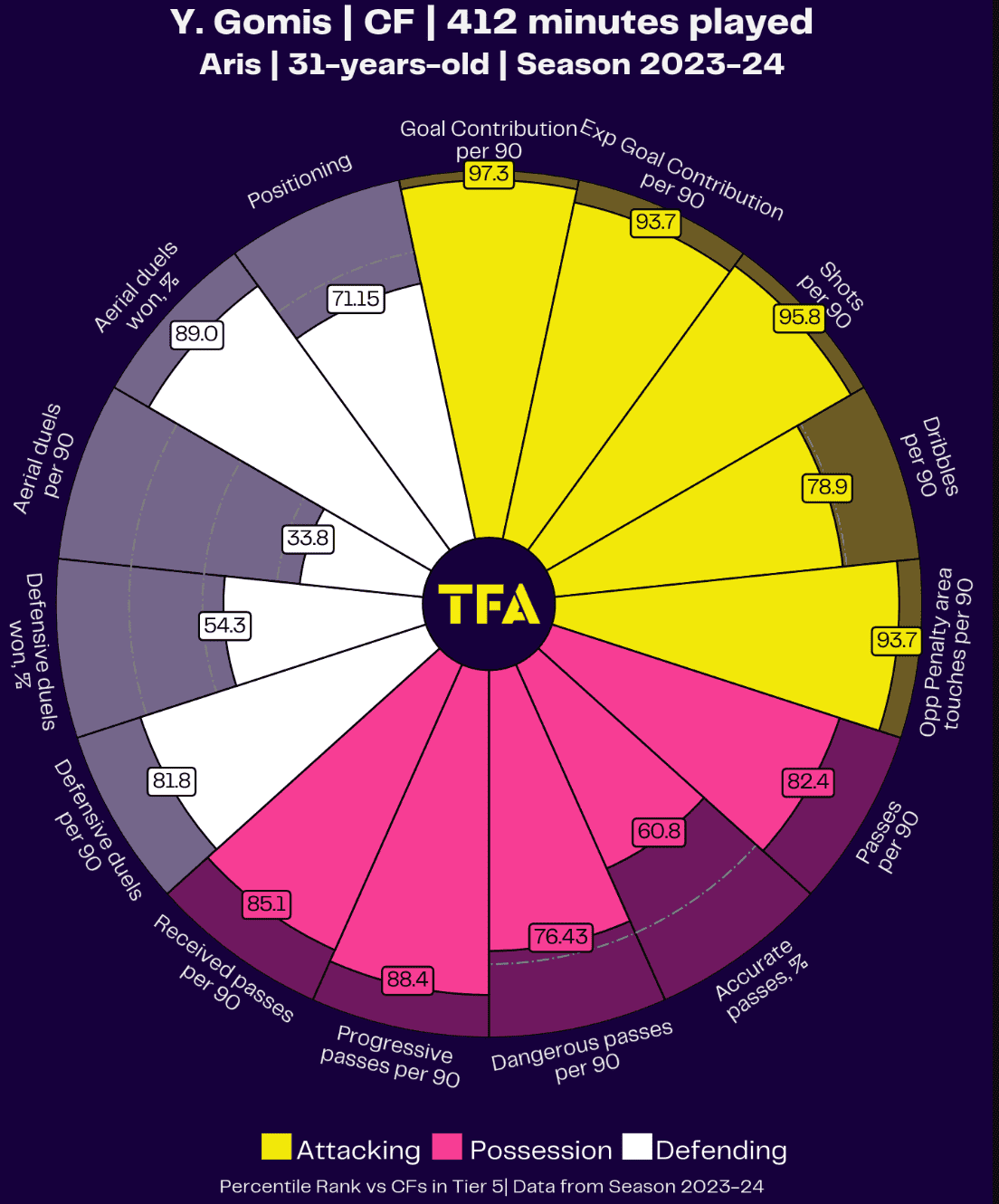
The pie chart above shows how Yannick Gomis ranks against all other strikers in the tier-5 leagues this season. Outside of dribbles per 90, Gomis has been one of the most clinical strikers in this selection of leagues, with the Senegalese striker ranking highly in every other attacking category. While he may not be the most well-rounded striker in possession, Gomis contributes a lot to the attack that is more than scoring goals. His 88th percentile rank for progressive passes per 90 minutes is above the average for players in his position.
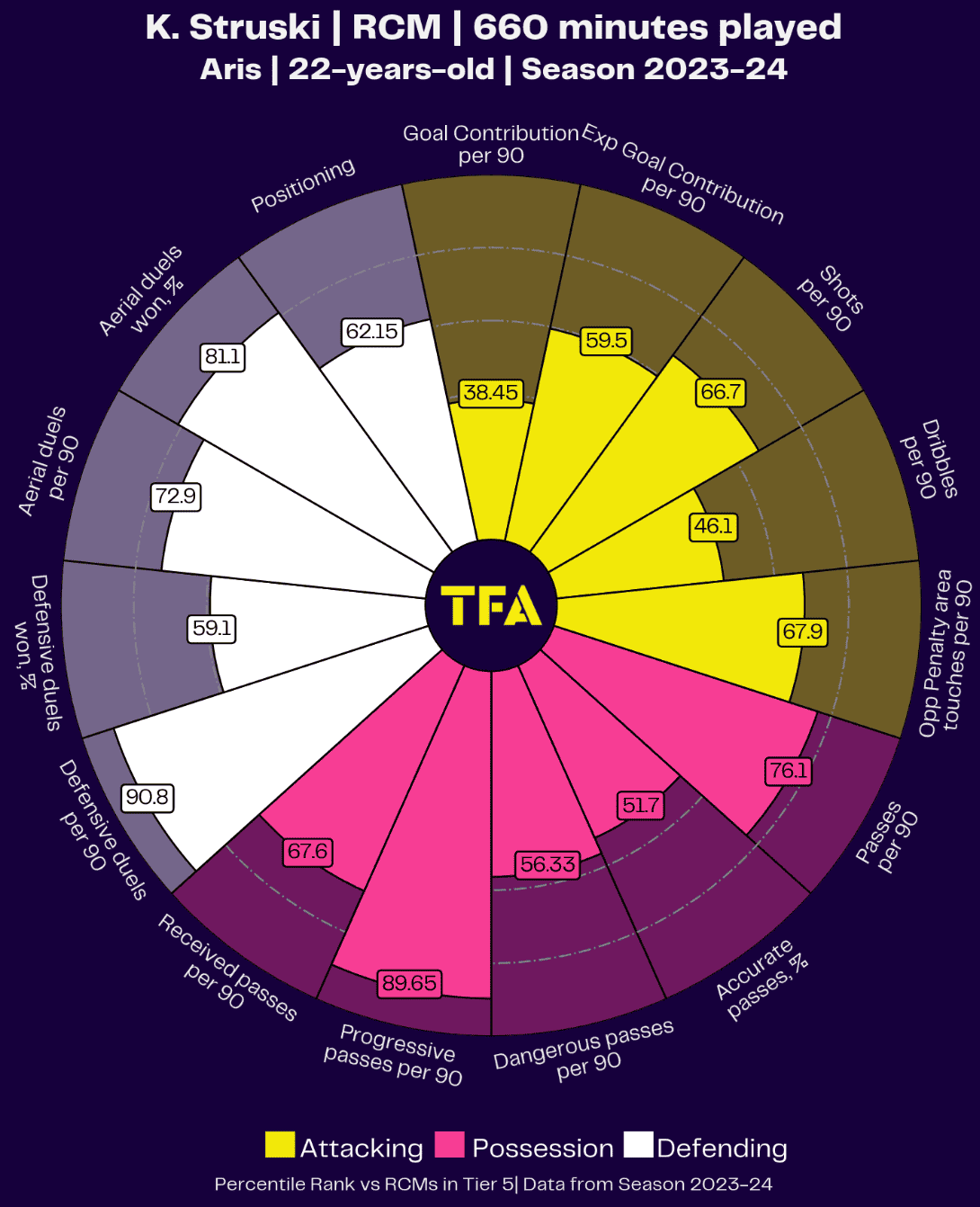
The other player we will look at in some more detail is 22-year-old Polish central midfielder Karol Struski. The midfielder has played in every match through all competitions for Aleksey Shpilevsky’s side this season, with the Belarusian coach obviously trusting him immensely in his style of play. Looking at the metrics in the pie chart figure shown above, it is not really like anything necessarily jumps off the page from the Polish midfielder.
However, the fact that he is well-rounded in essentially all of the categories shows the type of impact he has had for Aris Limassol this season. The 22-year-old plays as more of a box-to-box midfielder, though he tends to sit more in deeper areas and look to play vertically into the final third. He excels the most in the defending and possession metrics, showing that he can distribute as well as destroy in the centre of the park.
While a lot of the current Aris squad have been improved dramatically under Aleksey Shpilevsky, these two players, in particular, have had some of the most significant impacts this season. However, choosing when this team has been playing so well recently under their coach is hard.
Conclusion
This tactical analysis and scout report has shown that Aleksey Shpilevsky has been an enormous success at the club since being appointed in February of 2022. He has subsequently led the Cypriot club to the league and cup double in Cyprus while also now leading them into the group stages of a European competition. It was reported recently that Shpilevsky turned down an approach from Russian Premier League club Dinamo Moscow to become their new manager, but turned them down. As a result, it will be interesting to see what the future holds for the 35-year-old Aris Limassol head coach.





Comments